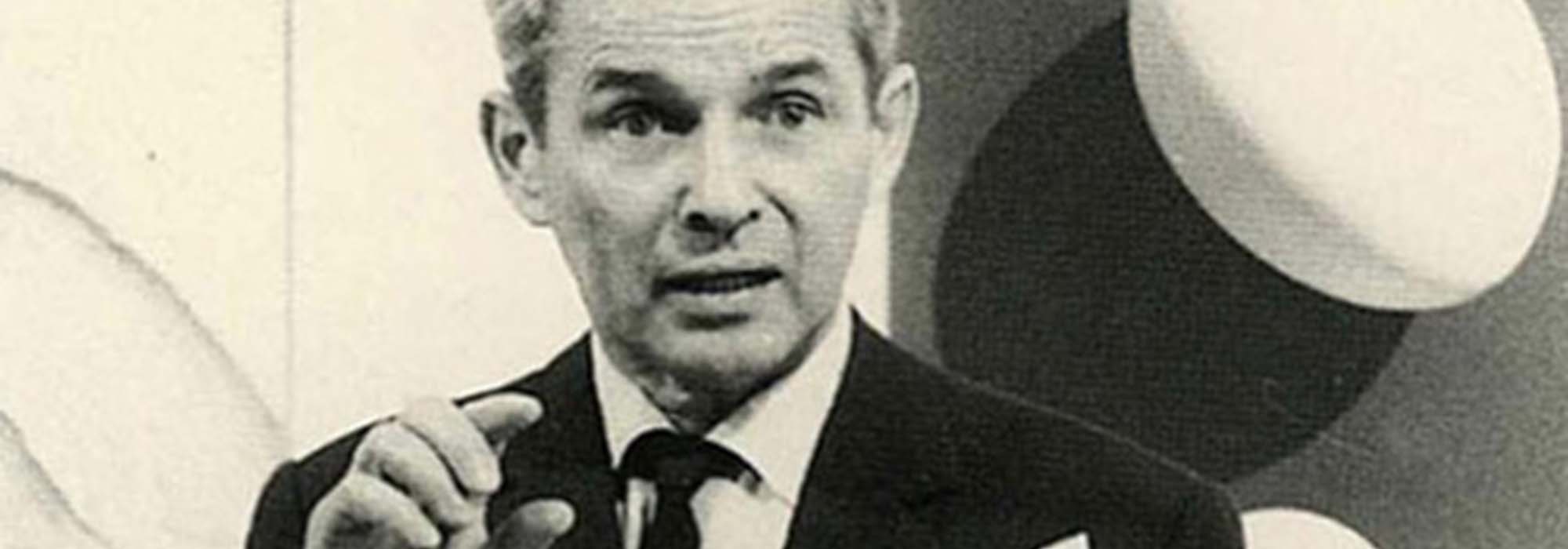Introduction
Ever since I was first introduced to Josef Müller-Brockmann and his work in the early weeks of my time as an IXD student, I have been heavily impressed by the way he approached his work as it was unlike anything any other designer was capable of doing at the time. Müller-Brockmann was, and still is, one of the most influential figures in graphic design and has changed my approach to design, opening my mind to new approaches I would have never considered before. In my essay today I will be discussing some of his most important fundamentals and methods, how they influenced design at the time and how they are still influencing my work today.
Background
Born in 1914 in Rapperswil, Switzerland, Müller-Brockmann attended the prestigious University of Zurich and the city’s Kunstgewerbeschule in his first steps to becoming a professional designer, studying architect, art, and design. He would go on to open his own Zurich studio in 1936 which he would specialize in photography, graphics and exhibition design and he established his position as the country’s leading practioner and theorist of swiss style (Famous Graphic Designers, 2020). Müller-Brockmann became known for his poster work that he began to do in the 1950’s in particular the ‘Musica Viva’ poster for the Tonhalle music concert. The simplicity of these posters is what impressed me the most and has influenced my work today as it has allowed me to become comfortable with having simple shapes and colours in my designs as they are effective. In the late 1950’s is the time marked as when he began his career as an art instructor, being appointed as a Professor of Graphic Design at the Kunstgewerbeschule in Zurich, where he would influence the next generation of designers.
Besides teaching and serving as design consultant, Müller-Brockmann also authored several books on graphic designing including his infamous ‘Grid systems in Graphic Design’ which has heavily influenced my work today, changing the way I think about the structure and layout of my content. He would go on to hold a number of one-man exhibitions in a range of countries worldwide, spreading the word about his unique design methods, eventually leading him to be awarded with a “gold medal to honour his work and cultural contribution” (Famous Graphic Designers,2020) by the State of Zurich in 1987. Müller-Brockmann died in Zurich on 30th August 1996 after living a life where he contributed to many different projects that helped shape graphic design today.

Swiss Style
Cleanliness, readability, and objectivity are just some of the key words that describe the driving force behind swiss style, the 19th century movement that marked the new separation of design from fine art to the new grid-based design. Josef Müller-Brockmann was one of the leading figures of the Swiss Design movement due to his poster work where he uniquely used typography, photographs, and simple images to create striking pieces of work. His commitment to grid-based design also seen him become a figurehead of swiss style as it brought new changes to his work that he had previously not considered. He would go on to publish “trilingual journal, Neue Grafik” (Famous Graphic Designers,2020) with it focusing on the swiss design style and its publication for international readers.
This journal would further cement Brockmann as the father of swiss style, influencing not only swiss designer but now designers worldwide. The structure and use of negative space in his work heavily influences my work today as it has shown me that our need to fill the entire page with content is false and sometimes having your content spaced out with some negative space brings an effective minimalistic style to my work. For me the use of white space in my work allows balance in my work, with keeping the user informed without giving them to much excess information that doesn’t help the design, making the main aims of my designs now to be simple and uncluttered.
In this sense Müller-Brockmann and his work post swiss design movement shows how modern his thinking really was as he drew influences from the Bauhaus and Constructivism something no other designer was doing at the time, and this is why I think his work today is still relevant and influential to me.
Poster Work
Some of the posters created by Müller-Brockmann are considered some of his best pieces of work, raising to prominence in the early 1950’s with his series of concert posters in Zurich which would pursue the ‘goal of graphical purity’ (International Poster Gallery, 2006). These posters were influential to me due to their simplistic but effective design, in particular the way in which he reduced the colour palette to its most simple, black, and white or one to two colours. For me the use of simple colours allowed his posters to emphasize the content on the poster, with the clean and straightforward sans-serif typefaces and point, line, plane-based designs.
His designs at the time were some that were rarely seen as they pushed towards being objective and pure in their approach. One of my favourite pieces of poster work that Müller-Brockmann designed was his Beethoven poster which he created in 1955, showcasing the main characteristics of his work; ‘clean typography, simple designs, and geometric shapes’ (Whitehead, 2017).
The arcs in the poster were placed by doubling the diameter of each arc, creating good spacing in the poster which in emphasized by the black and white colour scheme. For me Müller-Brockmanns use of the grid in the Beethoven poster is what’s most influential as it is a design aspect I use when designing my own work today, allowing me to keep my work structured, clean and effective.


Grid Systems
The most famous characteristic of Müller-Brockmanns work was his use of the grid, introducing the technique to Graphic Design, leading to it becoming a strong characteristic of swiss style also. His method influenced other designers at the time and influences my work today, as I use the grid when laying out most of the content of my designs. In 1981 Müller-Brockmann would publish a book titled, “Grid Systems in Graphic Design.” This book was seen to give designers a way to organise and design more efficiently and effectively. When I first learned of the grid I was fascinated by it as it gave me a simple way to consistently layout my work, making my designs structured and easy for the user to read and understand. Müller-Brockmann describes the grid system himself saying:
“The Grid system is an aid, not a guarantee. It permits a number of possible uses and each designer can look for a solution appropriate to his personal style. But one must learn how to use the grid; it is an art that requires practice.” (Josef Müller-Brockmann)
The Grid is seen by many as a way to show orderliness of design as it allows you to reduce the amount of visual elements in your design, instead using the grid to layout your content to show clarity and emphasize certain pieces of text or images that display important messages about the subject of the design. The grid encourages white space and through my use of the grid this is something I have become comfortable with in my own designs.
Before I discovered Brockmann and his methods I would have been uncomfortable with leaving major spaces with no content in my designs as I felt that if there is more content, the better my designs will be however this is not the case. The grid system has showed me the effectiveness of simple and clear designs with Müller-Brockmann himself saying “information presented with clear and logically set out titles…will not only be read more quickly and easily but the information will also be better understood.” (Müller-Brockmann, 1981). I agree with Brockmann in that the grid can excel in creating cleaner and simpler designs that are still effective, but for me the skill with using grids comes from knowing when you can use it and when you should break from its use.
Conclusion
It is clear to see that the many design methods that Josef Müller-Brockmannn has influenced generations of designers, with his prominent role in the swiss style movement and how his grid method is still used today by many designers across the globe, still influencing my work on a daily basis. His Poster work which used text, graphics and photographs was seen as a unique, approaching design in a way that no one else was doing at the time, and through this opening my and several other designers minds to new ways of approach. This work is most effectively seen in my opinion in his Beethoven poster where he experiments with the use of just 2 colours and simple shapes to present his content. The lessons he taught me on the grid systems have completely changed the way I approach a project, deciding when it is necessary to the use the grid and when it isn’t. He has inspired me to look at designing my work in a way that puts the designed content and most importantly the user first above all else.

Bibliography
Graphic Design History. (2009) Swiss | Graphic Design History [online]. Available at: https://visualartsdepartment.wordpress/swiss (Accessed 16th November 2021).
Famous Graphic Designers. (2020) Josef Müller-Brockmann [online]. Available at: https://www.famousgraphicdesigners.org/josef-muller-brockmann (Accessed: 16th November 2021)
Millman, D. (2013) Josef Müller-Brockmann “Swiss Style” [omline]. Available at: https://www.grapheine.com/en/history-of-graphic-design/graphic-designer-muller-brockmann-swiss-style (Accessed: 19th November 2021).
Budrick, C. (20020) Swiss Style: The Principles, the Typefaces & the Designers [online]. Available at: https://www.printmag.com/featured/swiss-style-principles-typefaces-designers/ (Accessed: 19th November 2021).
Meggs, P. and Purvis, A. (1983) A History of Graphic Design. [online]. Available at: https://www.dropbox.com/s/7frowwwe6ih8oy1/Philip%20B.%20Meggs%2C%20Alston%20W.%20Purvis%20-%20Meggs%27%20History%20of%20Graphic%20Design%20%282016%2C%20Wiley%29%20-%20libgen.lc.pdf?dl=0 (Accessed: 16th November 2021)
Müller-Brockmann, J. (1981) Grid Systems in Graphic Design. [ebook reader]. Available at: https://monoskop.org/images/a/a4/Mueller-Brockmann_Josef_Grid_Systems_in_Graphic_Design_Raster_Systeme_fuer_die_Visuele_Gestaltung_English_German_no_OCR.pdf (Accessed: 24th November 2021)
Whitehead, J. (2017) Beethoven poster by Josef Müller-Brockmann [online]. Available at: https://medium.com/fgd1-the-archive/beethoven-poster-by-josef-muller-brockmann-ce06940edf74 (Accessed: 24th November 2021).
